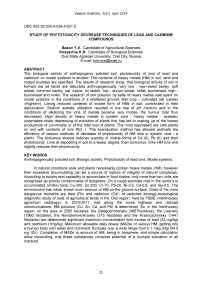Study of phytotoxicity decrease techniques of lead and cadmium compounds
Автор: Basov Y.V., Kozyavina K.N.
Журнал: Вестник аграрной науки @vestnikogau
Статья в выпуске: 2 (47), 2014 года.
Бесплатный доступ
The biological activity of anthropogenic polluted soil, phytotoxicity of ions of lead and cadmium on model systems is studied. The contents of heavy metals (HM) in soil, land and rooted biomass are specified. The results of research show, that biological activity of soil is formed low as lands are disturbed anthropogenically: very low - two-rowed barley, soft wheat, common barley, oat, lupine, oil radish; low - durum wheat, millet, buckwheat; high - buckwheat and millet. The research of soil pollution by salts of heavy metals was spent on model systems in the conditions of a sheltered ground, test crop - cultivated oat (variety «Fighter»). Liming reduced contents of mobile form of HMs in soil, contributed in their detoxication. Sodium acetate utilization resulted in the rise of рН medium and in the conditions of alkalizing the ions of metals became very mobile, the humus total thus decreased. High density of heavy metals in system «soil - heavy metals - acetate» undertakes sharp depressing of evolution of plants that has led to making up of the lowest productivity of commodity or of the total loss of plants. The most oppressed are oats plants on soil with contents of ions Pb2 +. The bioindication method has allowed estimate the efficiency of various methods of decrease of phytotoxicity of HM ions in system «soil - a plant». The biohumus sharply reduces quantity of mobile forms of Cd (II), Pb (II) and their phytotoxicity. Lime at depositing in soil to a lesser degree, than biohumus, links HM ions and slightly reduces their phytotoxicity.
Anthropogenically polluted soil, biologic activity, phytotoxicity of lead ions, model systems
Короткий адрес: https://sciup.org/147124533
IDR: 147124533 | УДК: 632.95.024.4-034.4:631.5
Текст научной статьи Study of phytotoxicity decrease techniques of lead and cadmium compounds
In natural conditions soils and plants necessarily contain heavy metals (HМ); however their excessive accumulating can be a source of rupture of integrity of natural complexes. According to toxicity and capability to accumulate in food chains, only more than ten units are recognized as priority contaminates of biosphere. On a rough estimate now in the world it is accumulated (million tons) Cu-300, Zn-200, Cr-70, Pb-20, Ni-3.5, Cd-0.6, and Hg-0.5. The environment has never known such amount of HM on the ground surface. Ones of the most dangerous toxicants are lead (Pb) and cadmium (Cd). At selective ecology-toxicological diagnostic study of soils of agricultural lands in the Orel region, held by FSBE «Verkhovsky agrochym radiology» in 2010-2011, had along the cores highway and railroad communications, HM pollution (Cu, Zn, Cd, and Pb) is determined. So, in the Verkhovsky region, on the area of 2585 hectares, the Zalegoshchensky (3667hectares), the Livensky (1960 hectares), the Novoderevenkovsky (315 hectares) and the Krasnozorensky (1441 hectares) are determined significant maximum concentration limit excess of lead (32 mg/kg) and cadmium (1mg/kg). Maximum allowable daily doses (MADs) of various HМ, getting into a human body with water and nutriment, fluctuate over a wide range from 0.1 mkg (Hg) B4 5 mg (Zn). Correlation of MADs to amount of HM, being in biosphere, and simple calculation allow concluding, that these substances comprise potential of a multiple toxication of all mankind.
MATERIALS AND METHODS OF RESEARCH
The purpose of the research is to study of biological soil activity of the anthropogenically polluted lands depending on crops growth and to study the mobility degree of cadmium compounds in soil and modes of decrease of its phytotoxicity. The principal objectives:
-
- To learn the influence of different crops on biological activity of anthropogenically polluted soils,
-
- To determine interconnection between a contents of mobile forms of HМ in soil and a plant;
-
- To learn a soil absorbing capacity under the influence of various factors (an organic matter contents, a lead and cadmium ion concentration, рН mediums);
-
- To learn the efficiency of various ways of decreasing phytotoxicity of lead and cadmium in system «soil-plant» by bioindication method.
The procedure of mass fraction measurement of mobile forms of metals (copper, lead, zinc, nickel, cadmium, cobalt, chromium, manganese) in samples of soil done by atomic-and-absorption analysis. The analyses of plant samples were done by a method of inversion voltammetry on polarograph AKV-07 MK.
The biological activity of soil in a layer of 0 - 20 cm was determined on percentage dissolving of cellulose in linen fabric (Dospekhov B.A., Vasilev I.P., Tulikov A.M., 1987).
Mathematical processing of the researches results was held on a computer with a software package «Polar 4.1». The researches were held under recommendations of B.A. Dospekhov (1985), V.I. Peregudov (1978), and B.A. Jagodin (1982). The accounting of an aboveground and rooted biomass was done according to G.S. Posypanov's method (1991).
Selection and agrochemical soil samples tests were held according to the customary and recommended methods (the Practical work on agrochemistry under the editorship of Mineev V.G, 2001), and also «Methodical directions of complex agrochemical diagnostic study of soils of agricultural lands» and «Methodical directions for the realization of field and laboratory investigations at the pollution control of the environment by metals».
Contents of HМ in soil, an aboveground and rooted biomass were determined by the following method: measurements of mass concentrations of HM gross forms in powdered samples of soils by means of X-ray fluorescence method on spectrometer «Spectroscan» (МVI-05-97) SPU «Spectron» St.-Petersburg, 1997.
The test was done on the experimental field of «Agroecology and Environmental Protection» chair of Orel State Agrarian University (I) and in protected ground of All-Union Scientific Research Institute of Grain Legumes and Cereal Crops of Russian Agricultural Academy (II) in 2010-2013. In the plot experiment the lead and cadmium translocation was investigated in agrocenosises on oats plantings (breed «Fighter»), buckwheat (breed «Nine») and mustards white. In model systems the leached chernozem (black soil) of the Livensky region was used. According to agrochemical indexes defined by high contents of organic matter (humus) it plays significant role for soil fertility and plant nutrition.
RESULTS AND DISCUSSION
The soil of the experimental field of the Orel State Agrarian University testing area is anthropogenically polluted, nearby there is high-way, farm works with utilization of bulky machinery are being carried out, and engineering construction works were done earlier.
For tests realization on the experimental field the following crops were sown: two-rowed barley, wheat soft, common barley, durum wheat, oats, lupine, oil radish, millet and buckwheat. The motley grasses area where melioration measures were not performed was used as control. The test replication was 4-fold.
The environmental conditions of the Orel region are favorable to cultivate grain legumes and grain crops. During the researches the total of daily mean temperatures above 10°С is 2200-2500°С, and weather conditions were not absolutely favorable for their cultivation.
For the soil activity detection on the experimental field the rate scale of biological activity of soils according to damage rate of cellulose (% of the decomposed canvas for a vegetative season) suggested by Zvyagintsev (1980) was used: very low activity < 10, low activity 10-30, mean activity 30 - 50, high activity 50 - 80, very high activity > 80.
Table 1 - Indicators of biological activity of soils
|
Crop |
% |
|
two-rowed barley |
9,97 |
|
soft wheat |
6,9 |
|
common barley |
8,05 |
|
durum wheat |
14,7 |
|
barley |
3,7 |
|
lupine |
4,45 |
|
oil radish |
4,25 |
|
millet |
23,15 |
|
buckwheat |
29,3 |
|
control |
16,55 |
Biological activity of soil on the testing area corresponds to:
-
- Very low - two-rowed barley, soft wheat, common barley, oat, lupine, oil radish.
-
- Low - durum wheat, millet, buckwheat;
-
- High - buckwheat and millet.
Generalizing investigation results one can draw a conclusion, that biological activity of soils is formed low because soil is anthropogenically disturbed.
Contents of toxicant ions in soil and their translocation in plants is the complex process depending on a variety of factors. To understand the mechanism of each of them influence is necessary to study the separate factors influence on phytotoxic effect of HM in the experimental conditions.
From the experimental field soil samples were selected and analyzed. Samples were selected before seeding in the field diagonally.
The results of analysis of soil samples from the experimental field of «Agroecology and Environmental Protection» chair from 17. 04. 2010 are presented in Tables 2, 3.
Table 2 - The results of analysis of soil samples from experimental field
|
№ |
№ of soil sample |
Analysis results |
|||
|
Zn, mg/kg |
Cu, mg/kg |
Pb, mg/kg |
Cd, mg/kg |
||
|
1 |
1 |
0,32 |
1,0 |
1,32 |
0,032 |
|
2 |
2 |
0,97 |
0,85 |
2,13 |
0,057 |
|
3 |
3 |
0,43 |
0,63 |
3,16 |
0,151 |
|
4 |
4 |
0,26 |
0,83 |
1,18 |
0,134 |
|
5 |
5 |
0,11 |
0,88 |
2,08 |
0,028 |
|
6 |
6 |
Less than 0,0025 |
0,92 |
1,44 |
0,118 |
|
7 |
7 |
0,12 |
0,94 |
2,10 |
0,037 |
|
8 |
8 |
Less than 0,0025 |
0,80 |
2,25 |
0,173 |
|
9 |
9 |
Less than 0,0025 |
093 |
2,86 |
0,043 |
Table 3 - The results of analysis of soil samples from experimental field
In order to avoid the soil contamination with HМ salts on the experimental field the researches were continued on model systems in the conditions of protected ground.
-
51 bottles were prepared for the test. Cultivated oat (variety «Fighter») capable to react quickly to influx and accumulation of HМs was chosen as test crop.
Test scheme:
-
1. Control (Background)
-
2. Soil +1 APC Pb
-
3. Soil +1 APC Pb + humus
-
4. Soil +1 APC Pb + lime
-
5. Soil +1 APC Pb + acetate Na
-
6. Soil +3 APC Pb
-
7. Soil +3 APC Pb + humus
-
8. Soil +3 APC Pb + lime
-
9. Soil +3 APC Pb + acetate Na
-
10. Soil +5 APC Cd
-
11. Soil +5 APC Cd + humus
-
12. Soil +5 APC Cd + lime
-
13. Soil +5 APC Cd + acetate Na
-
14. Soil +50 APC Cd
-
15. Soil +50 APC Cd + humus
-
16. Soil +50 APC Cd + lime
-
17. Soil +50 APC Cd + acetate Na
The test was carried out in triple replication.
According to approximate permissible concentrations (APC) of chemicals in soil (HN2) gross content of Cd on soils close to neutral, neutral (loam and argillaceous) at рН KCl > 5,5 the APC value (with background) corresponds to 2,0 mg/kg. Lead gross content on sand and sandy-loam soils is 32 mg/kg taking into account background, acid loam and argillaceous soils рН KCL <5,5, close to neutral, neutral (loam and argillaceous) рН KCl > 5,5.
The soil was sieved in advance to make a structure and then it was distributed into the vessels. According to the test scheme biohumus, lime, sodium acetate (to crate acid medium) were added. The vessels bottom was coated with keramzite on which the glass tube and the filter paper layer were fixed, and the soil was fed into.
After oat seedlings saline solution of Pb (CН 3 СОО) 2 *3Н 2 О (54.64% Pb) was applied into soil in doses 1 and 3 APC. It corresponded to 130.0 and 390.0 mg/kg Pb and salts Сd CdSO 4 (54% Cd), in concentrations 5 and 50 APC. This corresponded to Сd-10 mg/kg and 100 mg/kg of soil, taking into consideration background (clark) correspondingly.
Liming reduced content of mobile forms of HМ in soil, provided their detoxication. High content of the water-soluble organic compounds in soil solution did not result in increase of migration capability of metals due to formation of stable organo-mineral complexes. Sodium acetate utilization resulted in increase of рН medium and in the conditions of alkalizing ions of metals became very mobile, at that humus total decreased.
Then after biocrop growing within 30 days the soil was subjected to chemical analysis for content of gross and mobile forms of Pb and Cd (II) by method of atomically-absorbing spectroscopy to determine the fraction of HМ absorbing.
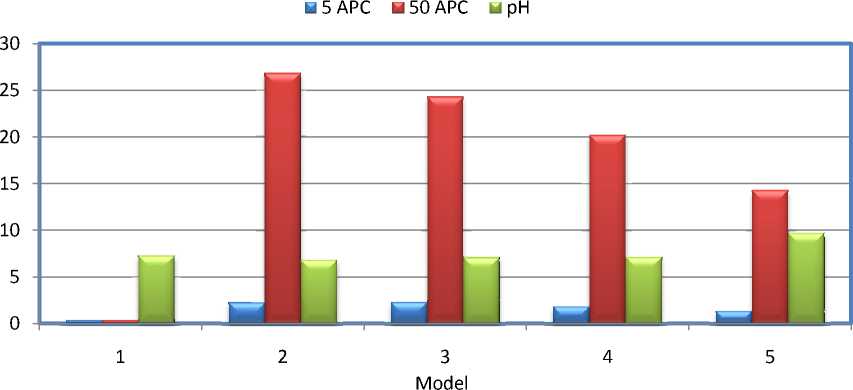
Figure1 - Contents of gross Cd (II) floor moulds, mg/kg
The obtained results indicate that with the increase of рН medium th e gr os s quantity of cadmium decreases. At Cd2 + application in soil solution, in quantities, 5-fold and 50-fold of APC, the maximum amount o f meta l is f ix e d by so il in ca se o f a p p lica tio n o f b io hu m u s a n d lime and also in pure soil. The minimum amount of ca d m ium is f ix e d b y so il with Sodium acetate application.
Behavior of Cd (II) is notably different from behavior of oth er h e a v y m e ta ls. I ts m o b ility is high in all mediums, even at lime application. Hypermobility o f c a dm i u m , a n d connected with it vulnerability of plant body from excessive ions of this element , is o n e of the rea so n s of its high toxicity.
Biohumus (Model. 3., Fig. 2) sharply reduces number of mobile f o rms of cadmium in soil, and as a result their toxicity. Lime at its application in soil to a l e sse r d egr e e, th a n biohumus, binds ions Cd2 +and reduces their phytotoxicity.
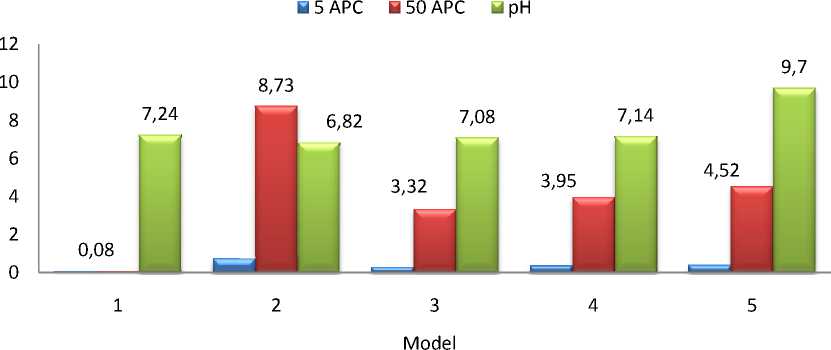
Figure 2 - Contents of gross Cd (II) floor moulds, mg/kg.
I n test v a r ia n ts e x ch a n ge a b le acid it y r em a in ed co n sta nt a n d co rr e sp on d s to 0 .01 mM/100g. The value of degree of base saturation is tak e n in to co nsid e r a tio n a t lime application. In o u r te st the t ot al a b so r b e d b a ses v a lu e in d iff e r e nt v a r ia n ts v a r ie s f r om 4 4 .7 to 45. 8 m M /1 00 g in re latio n to co n tr o l th a t in d ica tes in co n sid e r a b le n e ce ssi ty f o r lim in g (T a b le 4).
Table 4 - Agrochemical indicators of the investigated experience s yst em s
|
Var. |
Humus % |
The total absorbed bases mg.-eq./100g. |
The hydrological acidity mg.-eq./100g. |
I nt er c han g eable acidity mg.-eq./100g. |
|
1 |
6,5 |
46,02 |
0,26 |
0,01 |
|
2,10 |
6,1 |
45,81 |
0,25 |
0,01 |
|
3,11 |
8,5 |
45,37 |
0,24 |
0,01 |
|
4,12 |
7,8 |
45,55 |
0,25 |
0,01 |
|
5,13 |
4,9 |
44,7 |
029 |
0,01 |
|
6,14 |
6,1 |
45,76 |
0,23 |
0,01 |
|
7,15 |
8,6 |
45,32 |
0,22 |
0,01 |
|
8,16 |
8,5 |
45,43 |
0,23 |
0,01 |
|
9,17 |
4,8 |
44,76 |
0,26 |
0,01 |
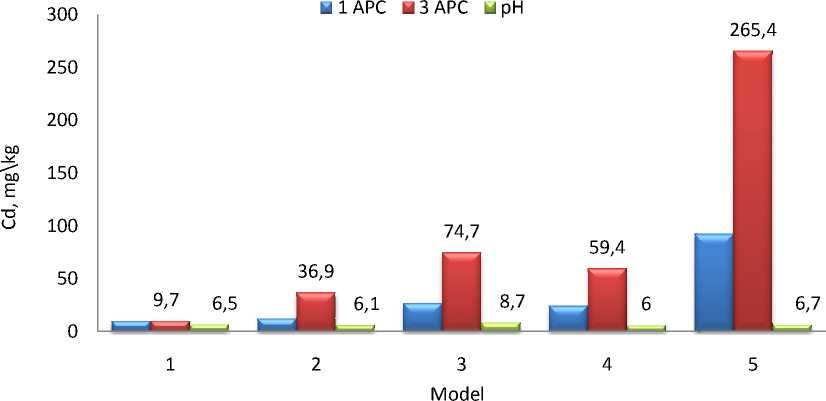
Figure 3 - Contents of grossPb (II) floor moulds, mg/kg
With growth of рН medium the gross quantity of lead is increased. A t P b 2 + application in soil solution, in quantities of 3-fold APC, the maximum amount of m eta l is f ix e d b y so il in case of biohumus application (var.3, 7) and lime (var. 4, 8), and also in so il w ith one metal addition (var. 2, 6). Abnormal high value Pb2 + with Sodium acetate a p plic ati on ( var. 5, 9) is motivated most likely by the running in the system hydrolysis p r o ce ss r e su lting in accumulating OH ions in soil solution.
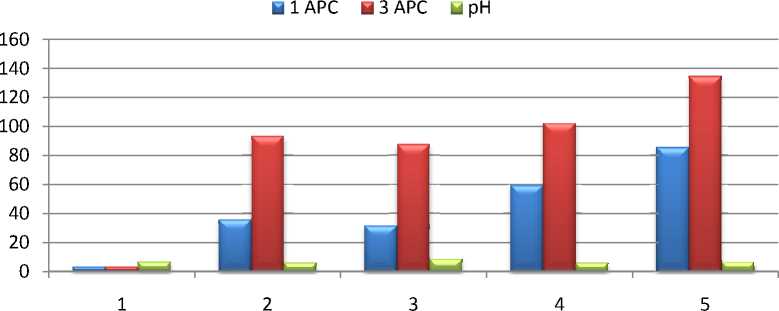
Model
Figure 4 - Contents of grossPb (II) floor moulds, mg/ k g
Taking into account the obtained data (Fig. 4), it is possible to conclude, that with growth of content of organic matter in soil (var.3,7) the quantity of mobile ion forms of lead decreases, and lime application (var.4,8) practically does not influence quantity of mobile forms of lead.
Lime is less effective way to decrease mobile forms of HМs in this case. Accessibility of lead for plants should depend on capability of compounds to release metal into a solution, comprising the interaction with evolved by roots ions Н + or anions of organic acids which bind metals in complexes.
During the tests the seedlings in variants 10 and 11 with adding Cd2 + and biohumus were the most unharmed. They differ in the longest leaves and a branched root system. The control seedlings looked well on their background. The plants with Sodium acetate were stunt. The data of the test are presented in Figures 5, 6, 7. On the 15th day of test one can note the healthy growth of oat crop on the soil – the control, and also vessels with utilization of lime and biohumus with cadmium concentration in 5 APC.
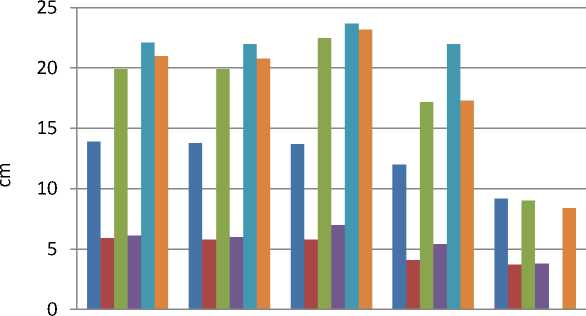
■ aboveground 1st decade
■ root 1st decade
■ aboveground 2nd decade
■ root 2nd decade
■ aboveground 3d decade
■ root 3d decade
1 10 11 12 13
Variants
Figure 5 - Dynamics of plants' evolution according to variants
Plants with Sodium acetate (var.13 and 17) turn yellow and fade, in spite of systematic watering and caring. Oat plants on soil with ions Cd2 + 50 APC content seem to be the most depressed.
At presence of heavy metals and CH 3 COONa (to create more acid medium) together in soil the growth of root system and plants top is stopped visually.
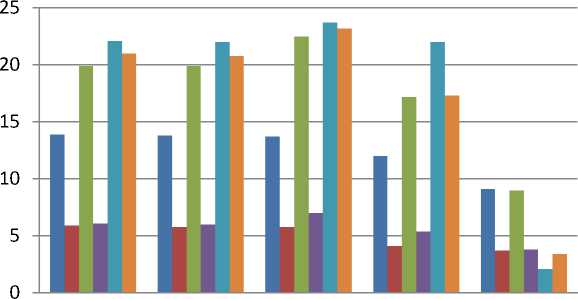
■ aboverground 1st decade
■ root 1st decade
■ aboveground 2nd decade
■ root 2nd decade
■ aboveground 3d decade
■ root 3d decade
1 14 15
16 17
Variants
Figure 6 - Dynamics of plants' evolution according to variants
At the end of the 3rd. decade the plants that had been cultivated on soil-control looked the most unharmed. The crop cultivated in system «soil - heavy metals - lime» strongly turns yellow and gets dry. Oat cultivated in system «soil - hard metals - Sodium acetate» (var. 17) dies out on the 30th day of test. The partial plants failure is observed in the tests with utilization of salts of heavy metals.
High concentration of heavy metals in system «soil - heavy metals - acetate» results in violent inhibition of plants development. This leads to extremely low productivity or the total plants failure. For this model system the maximum of mobile cadmium forms is detected.
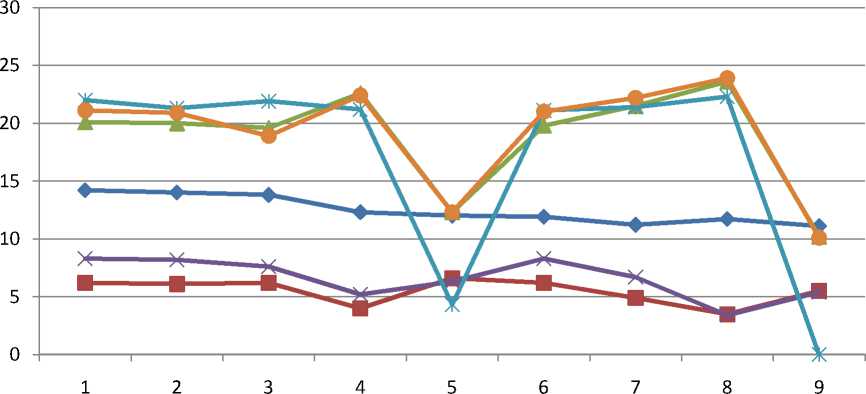
Variants overground 1st decade -■- root1st decade —*—overground 2nd decade root2nd decade overground 3d decade -•- root3d decade
Figure 7 - Dynamics of oats' evolution
At the beginning of research (1 dec.) seedlings with additions Pb2 + (var. 2, 6) and biohumus (var. 3, 7) looked the most unharmed. They differed in longer leaves and the branched root system. Oats seedlings on control (var. 1) looked well, and plants with Sodium acetate (var. 5, 9) were the most stunted. The experiment data are presented in Fig. 3. On the 15th day of test the intensive crop growth on soil-control (var.1), and also in the vessels with lime (var. 4, 8) and biohumus (var. 3, 7 with lead concentration in 1 and 3 APC is detected.
Plants with Sodium acetate (var. 5 and 9) turn yellow and fade, in spite of systematic watering and caring. Oat plants on soil with content of ions Pb2 + 3 APC seem to be the most depressed.
At presence of heavy metals and CH 3 COONa (to create more acid medium) together in soil the growth of root system and plants top is stopped visually.
On the 28th day on general background the plants cultivated on soil-control looked the most unharmed. The crop cultivated in system «soil - heavy metals - lime» (var. 4, 8) has considerably turned yellow. The oat cultivated in system «soil - heavy metals - Sodium acetate» (var. 9) on the 30th day of test dies out. The partial plants failure is observed in the tests with utilization of salts of heavy metals.
The significant concentration of heavy metals in system «soil - heavy metals - acetate» results in violent inhibition of plants development. This leads to extremely low productivity or the total plants failure. For this model system the maximum of mobile cadmium forms is detected.
Thus, the bioindication method has allowed estimating the efficiency of various techniques to decrease phytotoxicity of HM ions in system «soil - plant». It is proved that the biohumus violently reduces quantity of mobile forms of Cd (II) and Pb (II) and, in this connection, their phytotoxicity. Lime being applied in soil binds HМ ions in a lesser degree than biohumus, and slightly reduces their phytotoxicity.
CONCLUSION
On anthropogenically disturbed soils biological activity of soil is very low; however, it increases under buckwheat and millet crops.
Biohumus violently reduces quantity of Cd (II) and Pb (II) mobile forms and, in this connection, their phytotoxicity. Lime being applied in soil binds HМ ions in a lesser degree than biohumus, and slightly reduces their phytotoxicity.
Список литературы Study of phytotoxicity decrease techniques of lead and cadmium compounds
- Basov Y.V., Naumkin V.N, Lopachev N.A. Distribution of heavy metals in dark grey forest soil. Achievements of science and technology of Аgro Industrial Complex.-2000. -№ 12. -P. 8-9.
- Basov Y.V., Brusentsov I.I. Heavy metals in soil and plants. Conference of young scientists. Book of abstracts -Pushhino. -2004. -P. 203-204.
- Buravtsev V.N, Krylova N.P. Modern technological schemes of phytoremediation of polluted soils//Agricultural biology. 2005. №5. P. 67-73.
- Zakhvatkin Y.A. Grounds of general and agricultural ecology: methodology, traditions, prospects. -М: Mir, 2003. -360 p: -(Textbooks and studies. Manuals for students of Higher Educational Establishments).
- Kozyavina K.N., Basov Y.V. Study of phytotoxicity of lead ions on modeling systems. Vestnik of Orel State Agrarian University. Theoretical and science practical journal, №4 (43) August -P. 64 -69. Publ. Orel 2013.
- Klimova E.V. Interference of plants at ash constituents absorbing from soil (in the phytoremediation process of the soils polluted by heavy metals (cadmium, nickel). Environmental safety in Agro Industrial Complex. Abstract journal. 2005. №2. P. 314
- Kuznetsov A.Е, Gradova N.B. Scientific grounds of ecobiotechnology. Student training manual. -М: Mir, 2006. -504 p.
- Melnikov А.А. Environmental problems and its saving strategy: Work book for Higher Educational Establishments. -М: Academichesky prospekt; Gaudeamus, 2009
- Mironenko E.V., Ponizovsky A. A. Mathematical model for description of chemical balances in soils with heavy metals, low molecular weight organic and fulvic acids//Book of abstracts. Heavy metals in environment. Pushhino October, 15-18, 1996. P. 153-154.
- Practicum on agrochemistry: Work book. -2nd publ., revised and enlarged edition/under the editorship of academician Russian Academy of Agricultural Sciences. V.G. Mineeva. -М: Moscow State University publishing house, 2001. 369 p.
- Practicum on plant physiology. Work book. -2nd publ., revised and enlarged edition/under the editorship of Professor N.N. Tretyakov. -М: «KOLOS», 1982.
- Electronic source: http://www.newecologist.ru
- Electronic source: http://www.namusoril.ru
- Electronic source: http://bzhde.ru
- Electronic source: http://www.kadastr.org
- Electronic source: http://www.ecoportal.su

